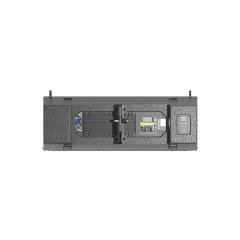For clear and powerful sound that can reach large areas, even larger than indoor PA systems are built for, an outdoor pa system must be properly set up. A quality outdoor public address speaker will only work as well as the rest of your setup allows it to so follow along with these 5 tips on how to do just this... Power output — The first thing to look at is the power output of your system. Outdoor installations in general require more oomph than indoor setups because sound disperses faster outside. For a fair-sized outdoor event where the sound needs to be able to reach all ends of an audience area with out distortion, you will generally need at least 2000 watts from your system.
Outdoor settings are a new challenge for speaker placement. Speakers need to be placed in order cover the entire audience at an even level, and eliminate reflections on nearby walls. For instance, raising speakers up to 10 or even 15 feet high on a platform can help direct sound over people and short fences. Tweaking of the speaker angles to direct sound directly at the audience, rather than having spill waste into non-listening areas. Playing music in a distributed manner with more than one speaker can cover wide ranges very effectively and makes sure that all the listeners even if they are far, every listener hears somewhat similar quality of sound.
The primary factor which impacts the performance of outdoor audio is weather. Weatherproof GearTo protect your gear against the rain, wind or dust all this time is essential using weather-resistant stuff. Speakers with IP ratings (Ingress Protection), like an IP54 or higher will be able to survive these conditions. Furthermore, setting the mixing console and other delicate equipment beneath tent or canopy also helps in giving shade. Wind is another influencer, making the sound travel sporadically. Installing simple windscreens near your microphones, and aiming the speakers downward just a bit can reduce some of this effect and improve sound clarity.
Trick 4 : Handle the sound dispersion carefully. Exposed brick and other open surfaces are what help sound travel additionally in an indoor venue. For out of doors events, line array systems are favored as they provide focused vertical dispersion plus a Horizontal coverage usually around 90-degrees. With this sort of setup, sound can reach a large group more uniformly without generating hotspots or dead zones. At big music festivals like Coachella, line arrays are employed a great deal to provide clear sound nearly very far away in up of 300 meters.

Another important thing to focus on is power distribution Another downside is that outdoor events will likely have A LOT of cable runs, which means more power loss. By using cables with heavy-gauge and less resistance lots, that loss is reduced, thus allowing the PA system to receive enough power voltage. Creating a balanced power system is also essential to avoid overloading it and for maintaining uniform performance throughout the process. Backup generators are commonly used as redundancy to power stability, especially during longer duration events.
Proper tuning and calibration are really needed for best sound quality. Newly developed Digital Signal Processing (DSP) enables real time adjustment to EQ, delay and other parameters for optimization of the outdoor environment For example, a subtle increase in lower frequency sounds can replicate the loss of bass experienced in open-air venues where bass notoriously disappears immediately. The tuning work needed to create balanced performance across all frequencies can be precisely made since a real-time analyzer (RTA) will show any frequency imbalance, documents the results.
This will stop them losing the signal or being interfered with while doing their job. The basic open-air nature of these types lends their own sets of challenges, from lengthy cable runs to risks such as moisture. Balanced cables, suchjson{type_link+other_feature-json}{/>#tcp-xlr #product-tce-trs], reduce interference when run over long distances. When creating a solid internet connection for your event, it is essential to couple all connections with weatherproof covers and cable management techniques (cable ramps) as well in order not only keeping compliant but also ensuring no tripping hazards are present too that could cause injury through damaged or cut cables.
This will need monitoring and control while the event is on going to maintain quality. This provides the option of tuning in a central control point to potentially respond on-the-fly based on how large (or small) the crowd is, weather changes or other unforeseen issues. This way, for instance a change in wind direction, the engineer can adjust speaker angles or an EQ setting to compensate. Real-time feedback Remote monitoring systems give you live feed back, no need to be near the mixing console hàng hiệu.
Finally, to create outdoor PA that works-- decide how much power you need/where its coming from, where the speakers can work (rain sun) /what coves pop and which wait: effectivity or efficiency; who delivers Power/t pi How souns aliplay — optimize settings for actual conditions-validate these se by usjng sa series of measurements tasks. Everything you do tackle these elements will help your sound reinforcement system drive clear audio to every attendee at a large-scale outdoor event, no matter the space or environmental factors.
